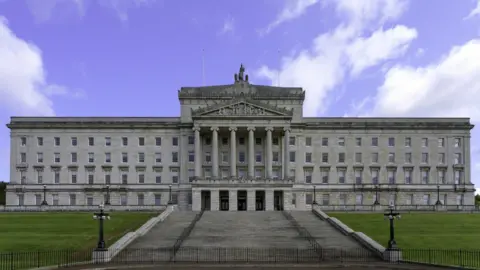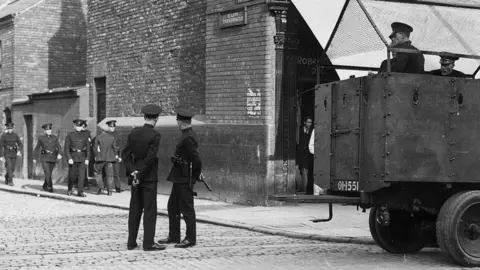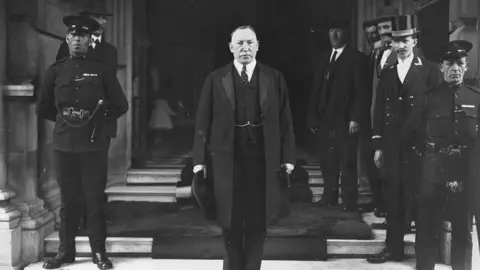NI 100: Building a 'mini-Westminster' in strife-torn Belfast
 Getty Images
Getty ImagesA century ago King George V officially opened the Northern Ireland Parliament, the beginnings of an institution that would govern most of the new state's affairs for 51 years.
It faced many challenges in its early years and half-a-century after it was abolished, it has a highly controversial and contested legacy - not least for how it acted towards NI's Catholic minority.
So how did this new parliament - the first devolved legislature in the UK - come into existence and how did it work?
Mini-Westminster
Unlike the modern devolved parliaments in the UK, the Northern Ireland Parliament was designed as a mini-Westminster.
It had two houses. The lower house, the House of Commons, was directly elected by the people and had 52 seats, while the upper house, the Senate, had 26, with 24 elected by the Commons and the other two held by the lord mayor of Belfast and the mayor of Londonderry.
The sovereign was represented by the governor of Northern Ireland, while the government was led by a prime minister at the head of a cabinet.
Even the layout of the chambers copied Westminster, with members facing each other across a central aisle. When the parliament moved to its permanent home of Stormont in 1932, the Great Hall emulated the central lobby of Westminster, with the lower house on the left on entry and the upper house on the right.
 Pacemaker
PacemakerThis emulation, according to Professor Graham Walker from Queen's University Belfast, extended beyond just symbolism.
"It really copied Westminster in terms of practices and procedures, committees, the electoral system after 1929 became first past the post," he says.
"I think there was a desire on the part of successive unionist governments not to diverge too much from Westminster legislatively, so they tended to reproduce legislation from Westminster, perhaps with some adjustments for Northern Ireland, but in essence the same kind of legislation."
Many other traditions from Westminster were also copied, as they are in Commonwealth countries such as Australia, including ministers speaking from a dispatch box.
Professor Walker also notes though that on some occasions the parliament did set its own agenda - picking out the 1937 Education Act as one example where it diverged from Westminster.
In addition the unique circumstances in Northern Ireland at the time meant the unionists who controlled the new parliament took their own line on security and civil rights.
Securing the new state
The Anglo-Irish War was continuing to rage, with the IRA making incursions across the border to take on the security forces in an attempt to secure an independent Irish republic made up of the whole island.
Faced with this threat and with ongoing sectarian violence which from June 1920 and July 1922 cost more than 450 lives in Belfast alone - 60% of which were Catholic - the new institutions were seen by unionists as a way to secure the future of the new state.
"There is no doubt that the very turbulent context around it actually coming into being had a great bearing on how it then developed," Prof Walker says.
"The tone was set early on."
 Getty Images
Getty ImagesA tough security policy which saw the establishment of the Ulster Special Constabulary and the use of internment without trial against IRA suspects was not the only approach which led many nationalists to view the parliament as a tool of the unionist majority.
The first two elections were held using a proportional electoral system, but the parliament voted to replace this from 1929 onwards, following a disappointing result for the Unionist Party in the 1925 election.
This helped solidify the party's majority. In addition, the boundaries of the new constituencies were drawn by the government, not by an impartial commission, leading to allegations of gerrymandering - a process which sees seats which should have majorities for one party manipulated to provide majorities for another party.
Some people also had more than one vote in NI Parliament elections until 1969. Business owners got an additional vote while graduates of Queen's University elected four MPs. Most, although not all, people in those two groups were Protestants.
For many nationalist opponents of the parliament, its role was summed up by the comments of Prime Minister Sir James Craig during a debate in the Commons in 1934, when he said: " In the south they boasted of a Catholic state. They still boast of Southern Ireland being a Catholic state.
"All I boast is that we are a Protestant parliament and Protestant state."
'No effective opposition'
Throughout its 50-year existence there was always a large unionist majority in the parliament and nationalists were excluded from government.
Nationalists continued to stand for election, but boycotted the parliament until 1925 when Nationalist Party leader Joe Devlin took his seat. Some individuals and occasionally the whole party boycotted at various points, but it was not until 1965 that the party became the official opposition.
The Northern Ireland Labour Party - a left-wing unionist party - also provided some opposition. At its height in the 1958 and 1962 elections it won four seats and was the official opposition.
Independent unionists and other small parties also provided some opposition to the huge Unionist Party majorities.
 Getty Images
Getty Images"There was no real effective opposition at any time," Prof Walker says.
"Maybe the late 50s, early 60s, when the NI Labour Party had four members and they actually did bring about some serious debate.
"The nationalists tended just to focus on what they considered to be their grievances rather than trying to suggest new policies or anything like that.
"So there wasn't much impetus for proper debate and discussion of policy. There was a kind of going through the motions aspect to it."
A part-time parliament?
When Terence O'Neill became prime minister in 1964, he remarked that his predecessor Lord Brookeborough did not even have a desk in his office.
Prof Walker argues that while O'Neill probably had a vested interest as a new PM in making such a remark, there were long recesses and ministers, including Prime Minister Sir James Craig, even had time to go on cruises while in office.
"There was a sense that it was a bit of a part-time parliament and I think part of that is that they didn't want to do anything adventurous with it," Prof Walker says.
"It's not that they lacked the potential to do something, because they had legislative powers over many areas, but they chose really to take the line of least resistance and just pass laws that paralleled those at Westminster."
The end
By 1972 the security situation in Northern Ireland had spiralled out of control. By the end of that year - the bloodiest of the Troubles - 480 people would be killed.
In the aftermath of Bloody Sunday in January 1972 - when 13 innocent people were shot dead by the Army in Derry - the British government prorogued the parliament and then abolished it completely in 1973.
Northern Ireland's current devolved assembly is a radically different legislature, but it sits in the same chamber at Stormont.

The BBC News NI website has a dedicated section marking the 100th anniversary of the creation of Northern Ireland and partition of the island.
There are special reports on the major figures of the time and the events that shaped modern Ireland available at bbc.co.uk/ni100.
Year '21: You can also explore how Northern Ireland was created a hundred years ago in the company of Tara Mills and Declan Harvey.
Listen to the latest Year '21 podcast on BBC Sounds or catch-up on previous episodes.
